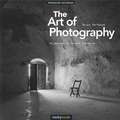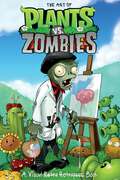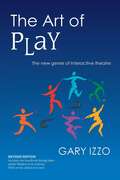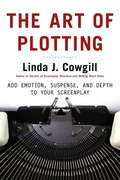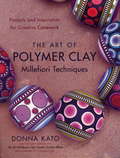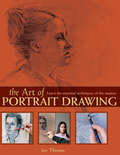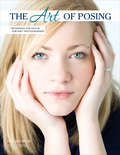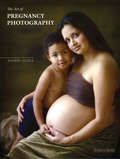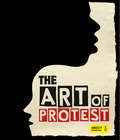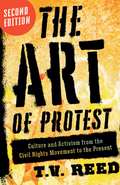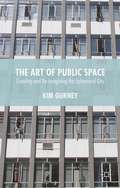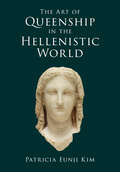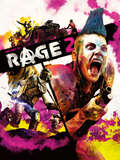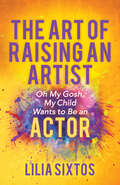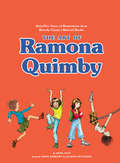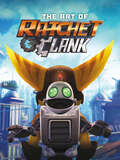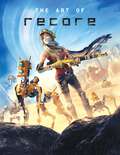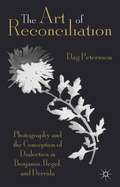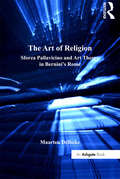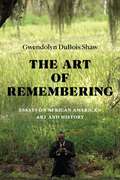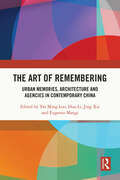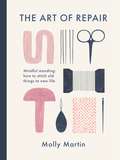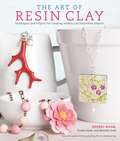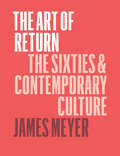- Table View
- List View
The Art of Photography
by Bruce BarnbaumThis is a newly revised edition of the classic book The Art of Photography (first published in 1994), which has often been described as the most readable, understandable, and comprehensive textbook on photography. In his accessible style, Barnbaum presents how-to techniques for both traditional and digital approaches. Yet he goes well beyond the technical as he delves deeply into the philosophical, expressive, and creative aspects of photography. This book is geared toward every level of photographer who seeks to make a personal statement through their chosen medium. Bruce Barnbaum is recognized as one of the world's finest photographers as well as an elite instructor. This newest incarnation of his book, which has evolved over the past 35 years, will prove to be an invaluable photographic reference for years to come. This is truly the resource of choice for the thinking photographer. Filled with over 100 beautiful photographs, as well as numerous charts, graphs, and tables. of photography. This latest incarnation of his textbook, which has evolved, grown, and been refined over the past 35 years, will prove to be an ongoing, invaluable photographic reference for years to come. It is truly the resource of choice for the thinking photographer.
The Art of Plants vs. Zombies (Plants vs. Zombies #0)
by VariousGet the story of the mulchifying super hit Plants vs. Zombies™ from the zombies' point of view. Part zombie memoir, part celebration of zombie triumphs, and part antiplant screed, this treasure trove of never-before-seen concept art covers Plants vs. Zombies, Plants vs. Zombies 2, Plants vs. Zombies Adventures, Plants vs. Zombies: Garden Warfare, and more! * Part art book—part zombie memoir! * Eighty-eight pages of "behind-the-leaves" material! * The original Plants vs. Zombies game has been installed over 100 million times and has 16 million active users!
The Art of Play: The New Genre of Interactive Theatre
by Gary IzzoNEW REVISED SECOND EDITION - With the recent surge of interactive performance venues, the demand for a definitive “how-to” guide to interactive improvisation has never been greater, The Art of Play fills the void with a warm, insightful, and often amusing collection of examples and anecdotes that illustrate the interactive process. Gary Izzo outlines a model interactive production that covers all aspects of interactive theatre, from concept through design and production. He also explains useful techniques in show development, character development, and ensemble improvisation. This revised second edition includes the director's handbook Acting Interactive Theatre in its entirety, and offers insider advice on how to workshop, rehearse and maintain an interactive production, and contains 165 fully annotated workshop exercises. Students of drama and the performing arts, teachers, and theatre and media professionals will find the practicality of The Art of Play invaluable. The study of play and the benefits of its techniques in freeing the imagination will appeal to anyone looking for good techniques for creativity, communication, and positive interaction. Gary Izzo was one of the first directors to experiment in the interactive theatre genre and has trained hundreds of actors in interactive and participatory theatre. He works as a freelance director, writer, producer, and teacher.
The Art of Plotting: How to Add Emotion, Excitement, and Depth to Your Writing
by Linda J. CowgillPlot must be as much about the emotions of the characters as it is about the events of the story. That's the message of The Art of Plotting, which teaches screenwriters how to integrate plot, characterization, and exposition to make stories compelling. Using examples from recent and classic movies, author Linda J. Cowgill demonstrates how the plot springs naturally from the characters--and how that technique makes audiences connect with the story on a more intimate level. Easy exercises reveal common plot problems and help writers overcome them.
The Art of Polymer Clay Millefiori Techniques: Projects and Inspiration for Creative Canework
by Donna KatoA thousand and one ideas for making beautiful polymer clay millefiori. In Venetian glassmaking, slender rods of molten glass are shaped, then cut to reveal amazingly detailed patterns: flowers, geometric shapes, dancing colors. These slices are called millefiori, “thousand flowers,” because they form a carpet of flowers when placed side by side. Now celebrity author Donna Kato shows crafters exactly how to re-create these intricate, fascinating designs in polymer clay. The Art of Polymer Clay Millefiori Techniquesreveals the entire process: how to work with the polymer clay, the basics of planning and creating a cane, and using color effectively. Dozens of canes, from simple to simply stunning, are included, and everything is clearly explained and illustrated with full-color photos, the Donna Kato way. Throughout the book, examples of stunning work by such millefiori artists as Kathy Amt, Pier Voulkos, and Kathleen Dustin provide inspiration. There must be a thousand ways to make beautiful millefiori . . . explore them all inThe Art of Polymer Clay Millefiori Techniques. From the Trade Paperback edition.
The Art of Portrait Drawing: Learn the Essential Techniques of the Masters
by Joy Thomas"Art is not what you see, but what you make others see."—Edgar DegasLearn how to turn what you see into masterful, expressive art. With the practical instruction and advice in these pages, you can develop the skills necessary to draw fine portraits in the realist tradition.In The Art of Portrait Drawing, skilled artist Joy Thomas passes on to you the lessons she has gathered from generations of the world's greatest artists. Learn about the golden mean, the traditional three-color portrait, the secrets of proportion and more methods used by the Old Masters and today's best artists alike!Inside you'll find:An introduction to every commonly used drawing medium, including charcoal, Conté and graphiteAn illustrated overview of the history of portrait drawingTime-honored methods for drawing accuratelyInsights on how to capture not only the likeness, but also the mood and essence of your subjectAdvice on posing a subject, setting up lighting, choosing the right tools and composing effectively9 in-depth, step-by-step drawing demonstrations to develop your skills and your confidencePortraying the human face is the ultimate expression of art. Use The Art of Portrait Drawing as the road map for your artistic quest.
The Art of Posing: Techniques for Digital Portrait Photographers
by Lou Jacobs Jr.From facial expression and body angles to camera optics and ideal lighting, this invaluable photography reference discusses all the facets of posing. Featuring 10 acclaimed photographers and their exceptional images, this detailed guidebook illustrates how each artist approaches the practice of posing and offers his/her advice on how to achieve more successful and visually appealing portraits. Business-related concerns are also addressed, ensuring that the professional photographer remains relevant and marketable in terms of composition and style.
The Art of Pregnancy Photography
by Jennifer GeorgeCapturing the beauty of pregnancy through photographs is an increasingly popular trend, and this timely guide covers the basics of maternity photography from both artistic and business standpoints. The details of creating a successful maternity portrait are addressed, including how to select a meaningful location, what props and fabrics to use, how to pose the subject, and how to produce a flattering lighting scheme. Helpful digital effects that can enhance skin tone and impart a wide variety of polished and artistic effects are discussed, as are tactics for incorporating other family members in the portrait. Also included are tips for building a strong connection with the subject that can lead to a profitable, lifelong client relationship.
The Art of Protest: A Visual History of Dissent and Resistance
by Jo RipponPresented in collaboration with Amnesty International, this stunning collection of more than a hundred posters charts a visual journey across more than a century of political and social activism. From the suffragettes of the early twentieth century to the upheavals of the 1960s and 1970s to contemporary, social-media-driven demonstrations of dissent and resistance, this illustrative history features iconic art from the archives of Amnesty International, work by world-renowned artists, and spontaneous posters from short-lived print collectives and activists on the ground.The Art of Protest covers key campaigns, global and local, including the refugee and climate crises, women's empowerment, nuclear disarmament, LGBTQ activism, Black Lives Matter, and issues around war and the misuse of the world's resources. These are images that have pushed boundaries as they give voice to the marginalized and confront those who would deny people their rights to peace and equality.
The Art of Protest: Culture and Activism from the Civil Rights Movement to the Present
by T. V. ReedA second edition of the classic introduction to arts in social movements, fully updated and now including Black Lives Matter, Occupy Wall Street, and new digital and social media forms of cultural resistanceThe Art of Protest, first published in 2006, was hailed as an &“essential&” introduction to progressive social movements in the United States and praised for its &“fluid writing style&” and &“well-informed and insightful&” contribution (Choice Magazine). Now thoroughly revised and updated, this new edition of T. V. Reed&’s acclaimed work offers engaging accounts of ten key progressive movements in postwar America, from the African American struggle for civil rights beginning in the 1950s to Occupy Wall Street and Black Lives Matter in the twenty-first century. Reed focuses on the artistic activities of these movements as a lively way to frame progressive social change and its cultural legacies: civil rights freedom songs, the street drama of the Black Panthers, revolutionary murals of the Chicano movement, poetry in women&’s movements, the American Indian Movement&’s use of film and video, anti-apartheid rock music, ACT UP&’s visual art, digital arts in #Occupy, Black Lives Matter rap videos, and more. Through the kaleidoscopic lens of artistic expression, Reed reveals how activism profoundly shapes popular cultural forms. For students and scholars of social change and those seeking to counter reactionary efforts to turn back the clock on social equality and justice, the new edition of The Art of Protest will be both informative and inspiring.
The Art of Public Space: Curating And Re-imagining The Ephemeral City
by Kim GurneyA journey through Johannesburg via three art projects raises intriguing notions about the constitutive relationship between the city, imagination and the public sphere- through walking, gaming and performance art. Amid prevailing economic validations, the trilogy posits art within an urban commons in which imagination is all-important.
The Art of Queenship in the Hellenistic World
by Patricia Eunji KimIn The Art of Queenship in the Hellenistic World, Patricia Eunji Kim examines the visual and material cultures of Hellenistic queens, the royal and dynastic women who served as subjects and patrons of art. Exploring evidence in the interconnected eastern Mediterranean and western Asia from the fourth to second centuries BCE, Kim argues that the arts of queenship were central to expressions of dynastic (and sometimes even imperial) consolidation, continuity, and legitimacy. From gems, coins, and vessels to monuments and sculpture, the visual and material cultures of queenship appeared in a range of sacred settings, public spaces, royal courts, and domestic domains. Encompassing several dynasties, including the Hecatomnids, Argeads, Ptolemies, Seleucids, and Attalids, Kim inaugurates new methods for comparing and interpreting visual articulations of queenship and ideal femininity from distinct yet culturally entangled contexts, thus illuminating the ways that women had an impact art and politics in the ancient world.
The Art of RAGE 2
by Avalanche StudiosAn outrageous collection of art and commentary from the development of id Software and Avalanche Studios' dystopian first-person-shooter, RAGE 2!Delving into the rebellious world of the Wasteland, this volume examines the most intense moments of RAGE 2 in an extensive fusion of art and commentary! Explore the split scenery of lush overgrowth and desolate deserts in concepts and renders from across the incredible setting. This wicked collection details the game's wide-open world, insane characters, and big f%$@ing guns--all with exclusive commentary from the game's developers.Dark Horse Books joins with Bethesda Softworks and id Software, the creators of the first-person shooter genre, to present The Art of RAGE 2. Don't miss out on this vital addition to any wild wastelander's collection.
The Art of Raising an Artist: Oh My Gosh, My Child Wants to Be an Actor
by Lilia SixtosThe Art of Raising an Artist guides parents in helping their children explore the world of acting and ultimately invest in their child’s future.Actor and director, Lilia Sixtos has seen thousands of auditions and taught hundreds of artists. By raising her two creative children, she has learned every possible way a creative person’s journey can be helped or hindered by their parents. In The Art of Raising an Artist, she shows parents how to:Identify the best training they can provide for their child within their meansDevelop a safe and loving space for the challenges of their child’s journeyCreate the support team their child needsFind their child’s nicheFit the needs of their child’s career with the needs of the whole family
The Art of Ramona Quimby: Sixty-Five Years of Illustrations from Beverly Cleary’s Beloved Books
by Anna KatzThe Art of Ramona Quimby celebrates the artists behind Beverly Cleary's inimitable Ramona Quimby series.The adventures of her iconic heroine have been brought to life by five different artists: Louis Darling, Alan Tiegreen, Joanne Scribner, Tracy Dockray, and Jacqueline Rogers.Readers can compare multiple interpretations of iconic scenes (remember the infamous egg-cracking incident?), read letters exchanged between Cleary and the first illustrator, and learn the stories behind the illustrations.• Celebrates the timeless work by these five artists since Beverly Cleary published the first Ramona Quimby book in 1955• Includes excerpts from the books• Two essays illuminate the series's narrative and artistic impactThe Art of Ramona Quimby explores the evolution of an iconic character, and how each artist has ultimately made her timeless.For fans of illustration and design, and for those who grew up alongside Ramona, this richly nostalgic volume reminds us why we fell in love with these books.• Beverly Cleary's bestselling children's series has sold over 50 million copies.• Great for readers who grew up with Ramona and Beezus, as well as parents, grandparents, and anyone who remembers reading these books when they were young• A must-have for fans of Beverly Cleary and the Ramona series, as well as anyone interested in illustrated character art and development over time• Perfect for those who loved The Secret Art of Dr. Seuss by Theodor Geisel, The Art of Eric Carle by Eric Carle, and Literary Wonderlands: A Journey Through the Greatest Fictional Worlds Ever Created by Laura Miller
The Art of Ratchet & Clank
by Sony Computer EntertainmentA retrospective exploration of the galaxy's most lovable video game heroes--Ratchet and Clank!For fifteen years the most unlikely heroes in the cosmos have been adventuring across the stars, kicking butt and taking names. Ratchet and Clank have rescued innocent civilizations, taken down evil corporations, defeated robot armies, incited space prison breakouts, and even colluded with interstellar pirates! Now, Dark Horse Books and Insomniac Games proudly offer a look back at the history of the iconic series in a Qwark-tastic collection of never-before-seen concept art and behind-the-scenes commentary chronicling eleven amazing games and the brilliant studio that created them!
The Art of ReCore
by ART TKFrom the legendary makers of Metroid Prime comes ReCore, an action-adventure game that pits the player against devious robotic foes while forging friendships with a courageous group of uniquely powerful robot companions!Now, Dark Horse Books presents this comprehensive volume, examining the art and inspiration behind this mysterious and dynamic world with The Art of ReCore!* Featuring commentary from the game&’s creators!* The essential companion to the highly anticipated game!* Collecting hundreds of pieces of never-before-seen art!
The Art of Reconciliation
by Dag PeterssonDag Petersson offers a comprehensive critique of the philosophy that has dominated 200 years of modern thought, politics, economy, and culture. The basic question is this: why does dialectical metaphysics fail to keep what it promises? What is it about dialectics, that makes it fall into irreducibly distinct variations of itself, when all it promises is to synthesize, to reconcile and make whole what is fragmented and alien to itself? An undisciplined creativity intrinsic to completing reason comes to light through analyses of how dialectical systems begin. Every dialectical philosophy must account for its own birth, and it is at this point, when it also articulates its promise of universal synthesis, that the book discovers a desire for light-writing, or photography. Only the most immediate element light can mediate the necessary self-determination of thought at its origin. Light must begin to write. A philosophical critique of dialectics is therefore also a point of departure for a new aesthetic ontology of photography.
The Art of Religion: Sforza Pallavicino and Art Theory in Bernini's Rome (Histories of Vision)
by Maarten DelbekeBernini and Pallavicino, the artist and the Jesuit cardinal, are closely related figures at the papal courts of Urban VIII and Alexander VII, at which Bernini was the principal artist. The analysis of Pallavicino's writings offers a new perspective on Bernini's art and artistry and allow us to understand the visual arts in papal Rome as a 'making manifest' of the fundamental truths of faith. Pallavicino's views on art and its effects differ fundamentally from the perspective developed in Bernini's biographies offering a perspective on the tension between artist and patron, work and message. In Pallavicino's writings the visual arts emerge as being intrinsically bound up with the very core of religion involving questions of idolatry, mimesis and illusionism that would prove central to the aesthetic debates of the eighteenth century.
The Art of Remembering: Essays on African American Art and History (The Visual Arts of Africa and its Diasporas)
by Gwendolyn DuBois ShawIn The Art of Remembering art historian and curator Gwendolyn DuBois Shaw explores African American art and representation from the height of the British colonial period to the present. She engages in the process of "rememory"—the recovery of facts and narratives of African American creativity and self-representation that have been purposefully set aside, actively ignored, and disremembered. In analyses of the work of artists ranging from Scipio Moorhead, Moses Williams, and Aaron Douglas to Barbara Chase-Riboud, Kara Walker, Kehinde Wiley, and Deana Lawson, Shaw demonstrates that African American art and history may be remembered and understood anew through a process of intensive close looking, cultural and historical contextualization, and biographic recuperation or consideration. Shaw shows how embracing rememory expands the possibilities of history by acknowledging the existence of multiple forms of knowledge and ways of understanding an event or interpreting an object. In so doing, Shaw thinks beyond canonical interpretations of art and material and visual culture to imagine “what if,” asking what else did we once know that has been lost.
The Art of Remembering: Urban Memories, Architecture and Agencies in Contemporary China
by Hua Li Jing Xie Yat Ming Loo Eugenio MangiFocusing on the non-Western context and case studies, this book explores theories of interdisciplinary architectural thinking and the construction of urban memory in Chinese cities, with an emphasis on contemporary architecture and the diversity of agencies.China has undergone one of the fastest urbanisation and urban renewal processes in human history, but discussions of urban memory in China have tended to be practice-oriented and lack theoretical reflection. This book brings together interdisciplinary architectural scholarship to interrogate the production of urban memory and examine experiences in China. The 14 chapters explore different processes, projects, materials, architecture and urban spaces in different Chinese cities by analysing cityscapes such as temples, bridges, conservation projects, architectural design, historical architecture, memorial hall, market street, city images, custom bike, food market and so on. The book deals with different agencies and methods, tangible and intangible, in the construction of memories aimed at promoting hybridised multiple identities, and explores the interplay of different versions of memory, i.e. state, public, regional, local, individual and collective memory.This book will be essential reading for scholars and students of architecture and urbanism, cultural studies and China studies, as well as architects, urban planners and historians interested in these fields.
The Art of Repair: Mindful mending: how to stitch old things to new life
by Molly MartinFor Molly Martin, it all started with a pair of socks. Her favourite pair. When the heels became threadbare, her mother got out her darning mushroom and showed her how to reinforce the thinning stitches and bring them back to life. She has been stitching and darning ever since.In The Art of Repair, Molly explores the humble origins of repair and how the act of mending a cherished item carefully by hand offers not just a practical solution but nourishment for the soul. Using her own beautiful illustrations, she guides us through the basics of the craft - from piecing and patching to the ancient Japanese art of Sashiko.This book will stay with you long after you put down your needle and thread. It offers an antidote to our increasingly disposable lifestyle, encouraging us to reconnect not just with the everyday objects in our environment but also with ourselves.
The Art of Repair: Mindful mending: how to stitch old things to new life
by Molly MartinFor Molly Martin, it all started with a pair of socks. Her favourite pair. When the heels became threadbare, her mother got out her darning mushroom and showed her how to reinforce the thinning stitches and bring them back to life. She has been stitching and darning ever since.In The Art of Repair, Molly explores the humble origins of repair and how the act of mending a cherished item carefully by hand offers not just a practical solution but nourishment for the soul. Using her own beautiful illustrations, she guides us through the basics of the craft - from piecing and patching to the ancient Japanese art of Sashiko.This book will stay with you long after you put down your needle and thread. It offers an antidote to our increasingly disposable lifestyle, encouraging us to reconnect not just with the everyday objects in our environment but also with ourselves.
The Art of Resin Clay: Techniques and Projects for Creating Jewelry and Decorative Objects
by Rachel Haab Sherri Haab Michelle HaabDiscover the Creative Possibilities of Resin Clay Imagine being able to imitate the look of rare coral, create oversized but featherweight statement jewelry, or mix clay with other mediums--all without firing. The Art of Resin Clay explores the creative potential of this material, in both air-dry and two-part formulas, and guides you through everything you'll need to get started: * Information on choosing the right kind of resin clay, essential tools and techniques, and safety guidelines* Tips for mixing colors, finishing, and adding jewelry findings* 20 projects covering a variety of creative techniques * Galleries of work by influential artists and crafts designers who use this versatile materialFrom the Trade Paperback edition.
The Art of Return: The Sixties and Contemporary Culture
by James MeyerMore than any other decade, the sixties capture our collective cultural imagination. And while many Americans can immediately imagine the sound of Martin Luther King Jr. declaring “I have a dream!” or envision hippies placing flowers in gun barrels, the revolutionary sixties resonates around the world: China’s communist government inaugurated a new cultural era, African nations won independence from colonial rule, and students across Europe took to the streets, calling for an end to capitalism, imperialism, and the Vietnam War. In this innovative work, James Meyer turns to art criticism, theory, memoir, and fiction to examine the fascination with the long sixties and contemporary expressions of these cultural memories across the globe. Meyer draws on a diverse range of cultural objects that reimagine this revolutionary era stretching from the 1950s to the 1970s, including reenactments of civil rights, antiwar, and feminist marches, paintings, sculptures, photographs, novels, and films. Many of these works were created by artists and writers born during the long Sixties who were driven to understand a monumental era that they missed. These cases show us that the past becomes significant only in relation to our present, and our remembered history never perfectly replicates time past. This, Meyer argues, is precisely what makes our contemporary attachment to the past so important: it provides us a critical opportunity to examine our own relationship to history, memory, and nostalgia.
